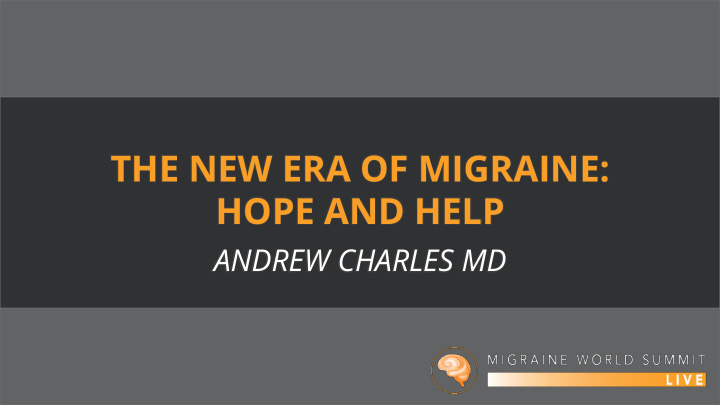



THE NEW ERA OF MIGRAINE: HOPE AND HELP ANDREW CHARLES MD
EXCITING TIMES FOR MIGRAINE – PROGRESS & HOPE
A JOURNEY IN HEADACHE MEDICINE… Glial Cells in Action Cool Scientist Brain Cell Communication
CORTICAL SPREADING DEPRESSION & MIGRAINE PET Scan showing waves of brain Andrew C. Charles and Serapio M. Baca activity during a migraine attack
MIGRAINE IS AN EXTRAORDINARILY INTERESTING AND IMPORTANT PROBLEM IN NEUROSCIENCE
MIGRAINE IS THE SECOND LEADING CAUSE OF TIME SPENT DISABLED OF ALL DISORDERS ON THE PLANET Most 1 Low Back Pain 16 Asthma Disabling 2 2 Migraine Migraine 17 Ischaemic Stroke Disorders 3 Age-related Hearing Loss 18 Dermatitis (YLDs) 4 19 19 Opioid Use Disorders Opioid Use Disorders Iron-deficiency Anaemia 2016 5 5 Major Depression Major Depression 20 Other Mental And Substance 6 Neck Pain 21 Dysthymia 6 Neck Pain 7 Other Musculoskeletal Disorders 22 Alcohol Use Disorders 8 Diabetes 23 Bipolar Disorder 9 9 Anxiety Disorders Anxiety Disorders 24 Edentulism 10 Falls 25 Neonatal Preterm Birth 11 COPD 26 Epilepsy 12 Osteoarthritis 27 Diarrhoeal Diseases 13 Acne Vulgaris 28 28 Tension Headache Tension Headache 14 Refraction And Accommodation 29 Ischaemic Heart Disease 15 Schizophrenia 30 Other Sense Organ Diseases
Maya DO THE MATH Migraine begins at age 12 , ends at age 65 (approx. 53 yrs.) 2 days 8 days 20 days per month per month per month Grand Total = Grand Total = Grand Total = 1,272 days with migraine 5,088 days with migraine 12,720 days with migraine 3.5 years of life 14 years of life 35 years of life in migraine prison in migraine prison in migraine prison
SHIFTING PARADIGMS OF MIGRAINE
BLOOD VESSELS DO NOT CAUSE MIGRAINE PAIN
TIMELINE OF A MIGRAINE EVOLUTION OVER 4 – 72 HOURS PREMONITORY AURA HEADACHE POSTDROME Yawning | Frequent urination Neck Pain | Fatigue | Mood change | Light sensitivity | Sound sensitivity Nausea | Vomiting Visual symptoms | Sensory symptoms | Language symptoms | Cognitive symptoms Headache Touch-sensitivity Hypothalamus Brainstem Cortex Cortex Brainstem Thalamus Hypothalamus Cortex Thalamus Hypothalamus
THE PATHOPHYSIOLOGY OF MIGRAINE: IMPLICATIONS FOR CLINICAL MANAGEMENT Multiple Genes Environment Hormones Metabolism Pharmaceuticals ?PFO Diffuse neurochemical & neurophysiological alterations Specific central/peripheral nervous system dysfunction Genes Neuro-peptide release CGRP Released Anatomy MIGRAINE ATTACK Hormonal & Metabolic State Migraine Familial Migraine Variable Attack w/ Aura Hemiplegic Migraine w/out Aura Features
THE CGRP STORY CGRP Administration CGRP Levels are Elevated Triggers Migraine in Chronic Migraine Small Molecule CGRP FDA Approval of anti-CGRP CGRP is Released Antagonists Abort Migraine monoclonal antibody therapies During a Migraine Attack for migraine prevention 2013 1990 2002 2004 2018 Cernuda-Morollon et al. Goadsby et al. Lassen et al. Olesen et al.
INJECTABLE MONOCLONAL ANTIBODIES TARGETING CGRP Erenumab Galcanezumab Fremanezumab Eptinezumab Aimovig Emgality Ajovy Episodic Migraine, Episodic Migraine, Chronic Migraine, Chronic Migraine, Episodic Cluster Episodic Cluster Episodic Migraine, Episodic Migraine, Studied for Chronic Migraine Headache, Headache, Chronic Migraine Chronic Cluster Chronic Cluster Headache Headache Monthly or Q3 month SC Syringe; Monthly SC Monthly SC Dosing Q3 month IV Autoinjector Autoinjector IV load for Chronic Migraine Target CGRP receptor CGRP peptide CGRP peptide CGRP peptide Presented (+) Regulatory status Phase 3 Episodic Migraine; FDA Approved FDA Approved FDA Approved as of March, 2019 May 17, 2018 September 14, 2018 September 27, 2018 Continuing Phase 3 Chronic Migraine
WHY THE CGRP STORY IS SUCH GOOD NEWS It Validates Demonstrates Opens The Door To Migraine Biology Migraine-specific Precision Medicine Treatments
Mouse Migraine RESEARCH Models Brain Imaging Retinal Imaging Role of the Neck Genetics Remote Monitoring
THERAPIES New ways of delivering current treatments Behavioral Therapy Neuromodulation New oral Diet medications Antibodies
Recommend
More recommend